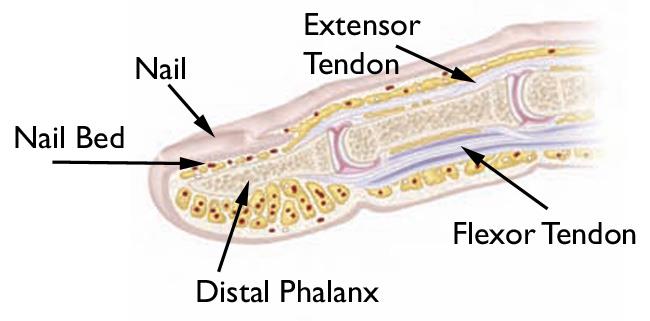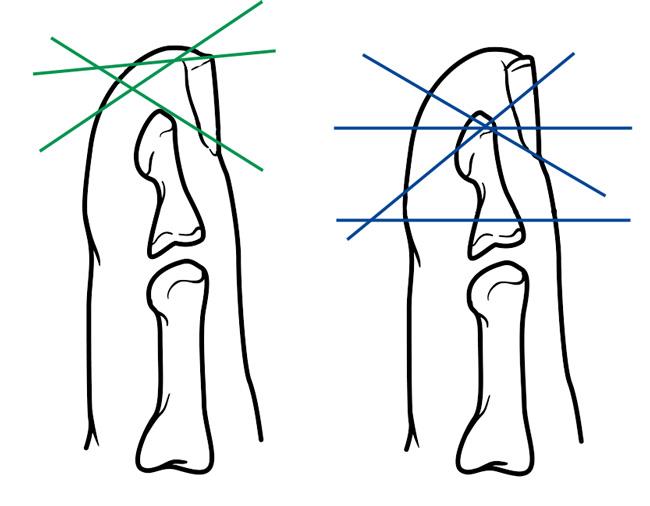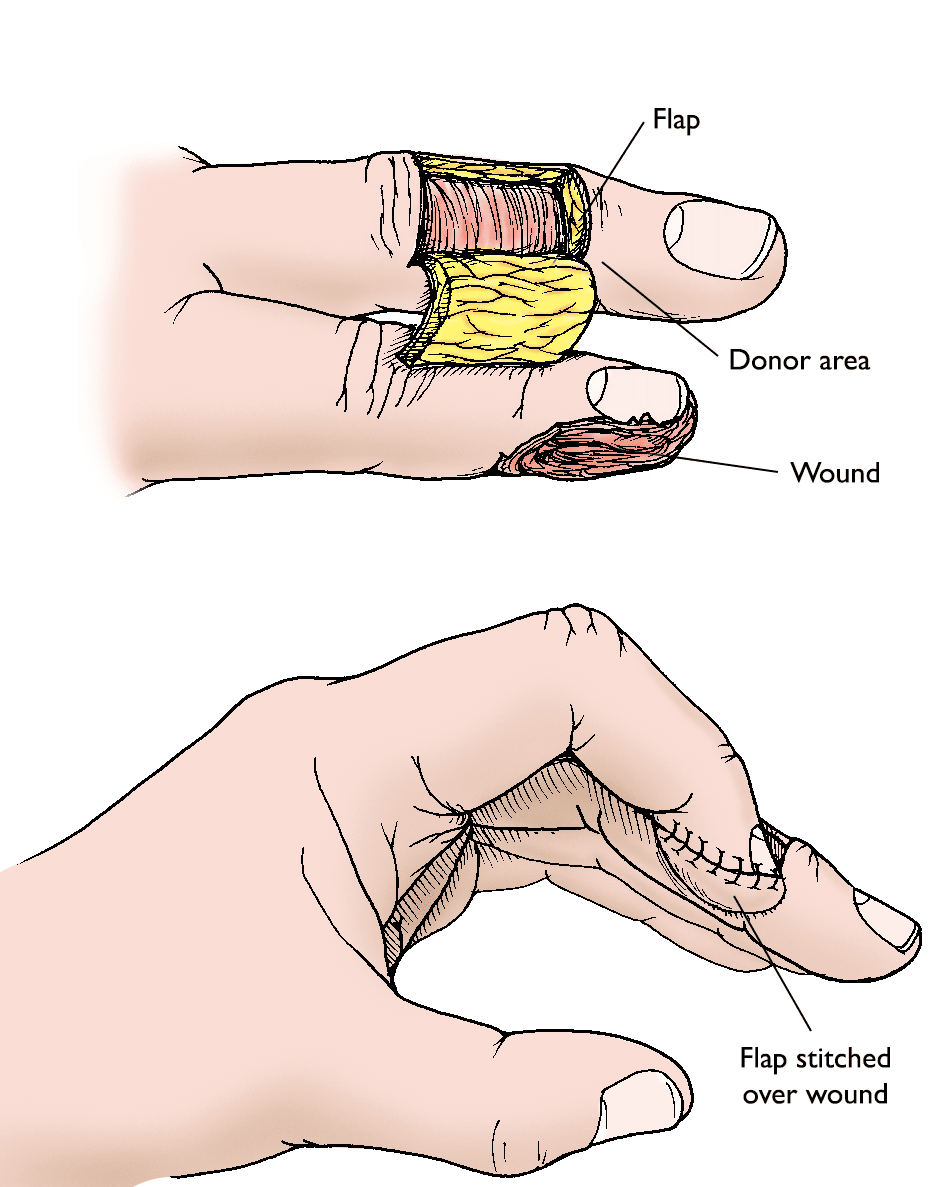Diseases & Conditions
Fingertip Injuries and Amputations
Fingertip injuries typically occur in accidents at home, at work, or during play. These injuries can involve:
- A sharp cut
- A crushing injury
- A tearing force
- A combination of these injury types
Amputations of the fingertip may be:
- Partial — some structures remain attached
- Complete — the entire fingertip is removed
Treatment varies depending on the severity and location of the injury, and the health of the patient.
An injury or amputation can damage any part of the fingertip, including:
- Skin and soft tissue
- Fingertip bone (distal phalanx)
- Nail and underlying nailbed
The tips of longer fingers tend to be injured more often because they are last to escape from harm's way.
Your fingertips are rich with nerves and are extremely sensitive. Without prompt and proper treatment, a fingertip injury can cause problems with hand function and may even result in permanent deformity or disability. To ensure the best outcome, it is important to have your doctor examine your finger or thumb soon after an injury.
First Aid
If you have injured your finger, do the following as you are preparing to go to the emergency room or see your doctor:
- Clean the injury with clean water or saline solution, if possible, and cover it with a lightly compressive sterile dressing to minimize bleeding and protect the injured finger.
- Elevate the injured hand so that it is higher than your heart to minimize swelling.
- Immobilize the affected hand and wrist with a short splint.
If your fingertip is completely cut off, do the following:
- Gently clean the amputated part with water or, if possible, with sterile saline solution.
- Cover it in a moistened gauze wrap.
- Place it in a sealed watertight bag, making sure there are no tears in the bag that could let water in.
- Place the bag on ice in a sealed container or another watertight bag.
- Do not allow the amputated part to be in direct contact with ice. You could damage it further.
- Go immediately to the emergency room, preferably at a hospital that has hand specialists immediately available.
Bring the amputated part with you to the emergency room and guard it carefully until the doctor is able to evaluate you.
Doctor Examination
Medical History
Your doctor will talk with you about your medical history and the circumstances of your injury. They will want to know:
- Whether you have any medical conditions, such as diabetes
- Whether you smoke
- Whether you take any medications
- Whether you have experienced a previous injury to the affected hand
To help plan your treatment, your doctor will ask several questions. These may include:
- How and when did your injury occur?
- Is the injured finger on your dominant hand?
- What do you do for a living?
- What are your recreational activities?
- Do you smoke or use tobacco products?
- Have you ever had hand problems caused by osteoarthritis or rheumatoid arthritis, diabetes, or any other medical condition?
- Is your tetanus immunization up-to-date?
Physical Examination and Immediate Care
Your doctor may give you a numbing injection (digital block anesthesia) to help reduce the pain in your injured finger. They will irrigate, or wash out, your wound with a saline solution to see it more clearly and to reduce the risk of infection.
Your doctor will examine your finger carefully, looking for:
- Exposed bone
- Missing tissue
- Injury to the nail and nailbed
Your doctor will then thoroughly clean out the wound, removing dead tissue and contaminants. This procedure, called "debridement, will reduce your risk for infection.
If your doctor suspects that you have broken bones, they may order X-rays. Some fingertip injuries can cause bleeding under the fingernail — a condition called subungual hematoma. If this is the case with your injury, your doctor may pierce your fingernail to relieve the pressure. They may also remove your fingernail if the nailbed underneath requires repair.
Your doctor may prescribe an antibiotic and/or give you a tetanus shot to prevent infection.
Treatment
The goal of treatment is to have a pain-free fingertip that is covered by healthy skin and functions normally. Your doctor will try to preserve the length and appearance of your finger.
Treatment for a fingertip injury or amputation depends on the angle of the cut and the extent of the injury. To determine the best treatment for your injury, your doctor will consider your general health and lifestyle, as well as your preferences.
Injury Without Exposed Bone
Minor tissue injury. If your fingertip wound is small and not deep enough to expose bone, it may heal on its own.
- Your doctor may place a protective dressing over the wound with instructions to change the bandage regularly.
- They may recommend that you wear a splint to protect the area while it heals.
- Your doctor may recommend that after 1 to 2 days, you soak your finger daily in a solution of warm, soapy water or saline solution with peroxide or betadine.
- After 2 days, you may start range-of-motion finger exercises to avoid stiffness.
- Complete healing usually takes 2 to 4 weeks, although stiffness and hypersensitivity (extreme sensitivity) may remain longer, depending on the severity of the injury.
Larger tissue injury. If your fingertip wound is large and open, there may not be enough remaining skin to heal and cover the open area.
In some cases, the wound may be left open to heal gradually on its own.
Sometimes, surgery may be required to ensure healing. Surgical procedures used to treat larger tissue injuries may include:
- Skin grafting. In this procedure, a piece of skin (skin graft) is taken from the outside of your hand, your forearm, or another area of your body and used to cover the injury. Both the wound and the donor site are closed with stitches during the procedure.
- Reconstructive flap surgery. Because a skin graft does not have its own blood supply, it may not be sufficient for some larger tissue injuries. If this is the case, your doctor may take a full-thickness flap of skin (the skin, plus the fat and blood vessels underneath) from a healthy part of your injured hand and use it to cover your wound. This procedure is discussed in greater detail in the section below.
Exposed Bone Injury
For injuries that expose the bone, there may not be enough tissue around the wound to stitch the wound closed. Sometimes, the bone needs to be shortened so that your wound can be stitched closed. Shortening the bone slightly usually does not hurt your ability to use your hand.
Reconstructive flap surgery. It may be necessary to cover the wound with new skin, as well as the fat and blood vessels underneath the skin. This is called reconstructive flap surgery.
The flap of skin and soft tissue is often taken from a healthy part of the same hand. Common donor areas are the injured finger itself, a non-injured finger, and the palm of the hand. A skin graft may be used to cover the donor area and to help it heal.
In some cases, the flap is not fully removed from the donor area. The flap is sewn over the wound but remains connected to the donor area (see illustration below). This is done to ensure a healthy blood supply to the flap as it heals over the wound. It typically takes a few weeks for the flap to heal over the wound and establish a blood supply from its new location. When this occurs, the flap will be detached from the donor area.
Your doctor may apply a bulky dressing to protect the area while it heals. They may also apply a splint to help support your hand. Most of your uninjured fingers will be left free.
Replantation. If your injury has cut off a large part of your fingertip, your surgeon may consider the pros and cons of reattaching the amputated part. This is called replantation.
Replantation is a complicated surgical procedure during which blood vessels are repaired to allow both the inflow and outflow of blood to the amputated part. A replantation can require significant recovery time for the patient. Depending on the type of amputation and the health of the patient, replantation may not always be possible or appropriate.
Fingertip Amputations in Young Children
Doctors treat fingertip amputations somewhat differently in children younger than 6 years of age. After thoroughly cleaning and preparing an amputated fingertip, the surgeon may reattach it to the finger. The fingertip may continue to grow relatively normally, even if bone was exposed. This is especially possible in children younger than 2 years of age.
Your child's doctor will consider many things when determining whether to reattach your child's amputated fingertip, including:
- Your child's age and general health
- The condition of the amputated part
- How the injury occurred.
Complications
In many cases, surgery can return a large degree of feeling and function to a fingertip injury. However, there are potential complications associated with both the injury itself and surgery for fingertip injuries. Your doctor will discuss each of the risks with you and will take specific measures to help avoid potential complications.
Possible risks and complications include:
- Infection
- Poor wound healing
- Persisting numbness or hypersensitivity
- Stiffness
- Abnormal nail growth
- Loss of viability (usability) in the amputated part
- Neuroma, or pain while the nerve is healing after the injury
- Bad reaction to anesthesia
Outcomes
Full recovery from a fingertip injury may take several months. After your injury heals, mild to severe pain and sensitivity to cold may continue for up to a year or may even be permanent.
Your doctor or a hand therapist may recommend specific exercises to improve range of motion and strengthen your hand and fingers. They may also suggest additional therapies to help promote healing and function. These therapies may include:
- Heat and massage
- Fingertip desensitization
- Electrical stimulation of the nerves in the hand
- Splinting
- Special compression wrappings to control swelling
- Activities to improve fine motor skills such as pinching and grasping
Most patients with fingertip injuries end up with good results. Even patients with partial loss of fingers tend to function quite well after a period of healing and adjustment.
Last Reviewed
May 2022
Contributed and/or Updated by
AAOS does not endorse any treatments, procedures, products, or physicians referenced herein. This information is provided as an educational service and is not intended to serve as medical advice. Anyone seeking specific orthopaedic advice or assistance should consult his or her orthopaedic surgeon, or locate one in your area through the AAOS Find an Orthopaedist program on this website.









